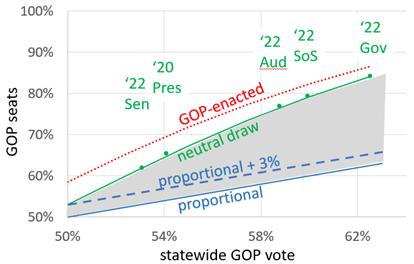Could "snake-on-the-lake" re-emerge from well-meaning attempt at fair districts?

Geoff Wise leads the Anti-Gerrymandering Task Force for JoinTheUnion.US. He lives near Cincinnati.
There’s nothing more fundamental to American democracy than the opportunity for citizens to elect people who will faithfully represent them in government.
In 2015 and 2018, Ohioans overwhelming approved constitutional amendments to stop partisan mapmakers from infringing on this basic right. But here we are, two years and seven unconstitutional maps into the 2021 redistricting cycle with no end in sight. This flagrant disregard of the will of the people should disqualify Ohio politicians from ever drawing another district map.
The good news
The “Citizens Not Politicians” group has recently drafted an amendment petition for an independent redistricting commission modeled on Michigan’s success.
The petitioners have clearly thought long and hard about how to construct and operate the commission. And as the person who led the months-long 88-county slog to collect Ohio’s 2022 precinct boundaries, I appreciate the petition’s requirement that the secretary of state deliver this critical data to enable the commission’s work.
The bad news
This new petition has a fatal flaw.
It decrees a 3% cap on disproportionality, the deviation of each party’s expected seats from its statewide vote based on the median of recent statewide elections.
Proportionality has intuitive appeal; in a balanced (50-50) state, each party should get half the seats. But when there’s one representative per district, the majority party tends to pick up much more than 1% in seats for every 1% gain in vote above 50-50. This disproportional responsiveness is a natural consequence of having a healthy number of competitive districts with a mix of red and blue voters.
In most Republican-leaning states, the clustering of Democrats in urban areas adds to the expected disproportionality when maps are drawn neutrally — that is, without using partisan data.
The graph below compares the 3% disproportionality cap to Ohio’s neutral-draw Congressional expectation for some recent statewide elections.

For a balanced state like Michigan, you can achieve near-proportionality pretty easily. But how do redistricting commissions in unbalanced states deal with the growing chasm between proportionality and a non-partisan draw?
In California and Colorado, they don’t close their eyes and wish it away.
They grapple with it, building consensus for a reasonable balance that respects communities of interest. For example, Colorado’s 2021 legislative commission formulated a plan that gives each party half the seats at a 50-50 vote but allows the majority party to win about 64% of the seats at a realistic 55% of the vote.
I took a similar approach in my 2021 proposals to the Ohio Redistricting Commission.
But after all this petition’s care in setting up a high-quality independent commission, that commission is not entrusted to find the right balance between proportionality and a neutral draw. Instead, they are handcuffed to enforce a seat quota for the minority party. I don’t see how this will get enough Republican votes to pass.

A non-starter
More importantly, proportionality-driven mapmaking gets really ugly when the statewide vote is closer to 60-40 than 50-50. If Ohio’s future median election looks like the 2022 governor’s race (62-37), mapmakers would have to wring an extra dozen Democratic seats out of the Statehouse map.
To meet quotas, they’d be forced to dilute urban voters across districts and drain blue voters out of light red districts. Will we have to resurrect 2011’s infamous "snake-on-the-lake" with no competitive GOP districts?
I foresee challenges even at 58-42, the median result in 2022 statewide elections.
When I asked Citizens Not Politicians about this, I got vigorous verbal assurances, but no proof. I’m worried that their redistricting expert has not even requested the 2022 shapefiles to run these tests.
They need to publicly post example map data files to prove their unconventional scheme is robust at 60/40 and beyond, to protect against unpredictable drifts in future decades.
And since the Democrats would get six Congressional districts whether the median election is 57-43 or 63-37, they need to explain why it’s healthy to encourage Democrats to lose unwinnable statewide races by larger margins to get more favorable districts.
I want to get behind this redistricting reform, but imposing the cult of proportionality is a non-starter in a GOP-leaning state and creates some of the same problems as GOP gerrymandering.
We’ve have plenty of time before next November to work together on a more robust proposal that a strong majority of Ohioans can support.
Geoff Wise leads the Anti-Gerrymandering Task Force for JoinTheUnion.US. He lives near Cincinnati.
This article originally appeared on The Columbus Dispatch: Can redistricting reform bring back Ohio infamous "snake-on-the-lake?"

